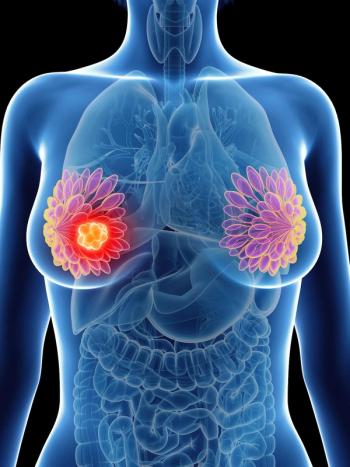
- ONCOLOGY Vol 14 No 8
- Volume 14
- Issue 8
Doxorubicin/Docetaxel Is Superior to Standard Doxorubicin/Cyclophosphamide as First-Line Chemotherapy for Metastatic Breast Cancer: Randomized Phase III Trial
Between June 1996 and March 1998, 429 first-line metastatic breast cancer patients were randomized to receive AT (doxorubicin [Adriamycin] 50 mg/m² and docetaxel [Taxotere] 75 mg/m²) or AC (doxorubicin 60 mg/m² and cyclophosphamide [Cytoxan, Neosar] 600 mg/m²), day 1 every 3 weeks for a maximum of eight cycles.
Between June 1996 and March 1998, 429 first-line metastatic breast cancer patients were randomized to receive AT (doxorubicin [Adriamycin] 50 mg/m² and docetaxel [Taxotere] 75 mg/m²) or AC (doxorubicin 60 mg/m² and cyclophosphamide [Cytoxan, Neosar] 600 mg/m²), day 1 every 3 weeks for a maximum of eight cycles.
Granulocyte colony-stimulating factor (G-CSF, filgrastim [Neupogen]) was not allowed, except after a prior febrile neutropenic complication. Eligible patients were required to have metastatic disease with measurable or evaluable lesions. No prior chemotherapy (CT) for metastatic breast cancer was allowed; prior nonanthracycline adjuvant CT was allowed.
Baseline characteristics were well balanced. Overall, patients had a median age of 53, a median Karnofsky performance status of 90, and a median disease-free interval of 25 months; 42% of patients had had adjuvant CT. The following organs were involved: visceral 63%, bone 54%; 41% of patients had three or more organs involved. The main reasons for discontinuing treatment were as follows: reaching eight cycles, 49% (AT) vs 36% (AC); progressive disease, 21% (AT) vs 32% (AC); toxicity, 13% (AT) vs 13% (AC). The median number of cycles was 8 (AT) vs 7 (AC). Median cumulative dose of doxorubicin (CDA) was 378 mg/m² (AT) vs 420 mg/m² (AC). Median relative dose intensity (RDI) was 96% (AT) vs 96% (AC).
Severe (National Cancer Institute grade 3/4) events occurring in ³ 1% of cycles included neutropenia, 82% (AT) vs 69% (AC); febrile neutropenia, 7% (AT) vs 2% (AC); anemia, 3% (AT) vs 4% (AC); infection, 1% (AT) vs < 1% (AC); nausea, 1% (AT) vs 1% (AC); vomiting, 1% (AT) vs 1% (AC); stomatitis, 1% (AT) vs 1% (AC); diarrhea, 1% (AT) vs < 1% (AC). Severe asthenia was seen in 8% (AT) vs 3% (AC) of patients; severe edema was seen in 1% (AT) vs 0% (AC) of patients.
Left ventricular ejection fraction decrease ³ 30 points from baseline occurred in 1% (AT) vs 6% (AC) of evaluable patients. Clinical congestive heart failure (CHF) was seen in 3% (AT) vs 4% (AC) of patients. The CDA was > 360 mg/m² in 54% (AT) vs 64% (AC) of patients. Toxic deaths occurred in 1 AT patient (CHF) and 4 AC patients (1 sepsis, 3 CHF). As of April 1999, the median follow-up is 18 months.
CONCLUSION: AT shows superior efficacy over standard AC in metastatic breast cancer, despite a lower dose intensity of doxorubicin. Neutropenia and its complications were higher in AT but did not compromise RDI. Other toxicities were similar in both arms. The AT advantage is also being tested in early breast cancer.
Articles in this issue
over 25 years ago
Commentary on Abstract #280over 25 years ago
Commentary on Abstract #527over 25 years ago
Commentary on Abstracts #986 and #1015over 25 years ago
Commentary on Abstract #1916over 25 years ago
Commentary on Abstracts #341, #347, and #333over 25 years ago
Commentary on Abstracts #407 and #424over 25 years ago
Commentary on Abstracts #349 and #1259over 25 years ago
Commentary on Abstracts #317 and #322over 25 years ago
Commentary on Abstracts #254 and #330over 25 years ago
Commentary on Abstract #336Newsletter
Stay up to date on recent advances in the multidisciplinary approach to cancer.


















































































